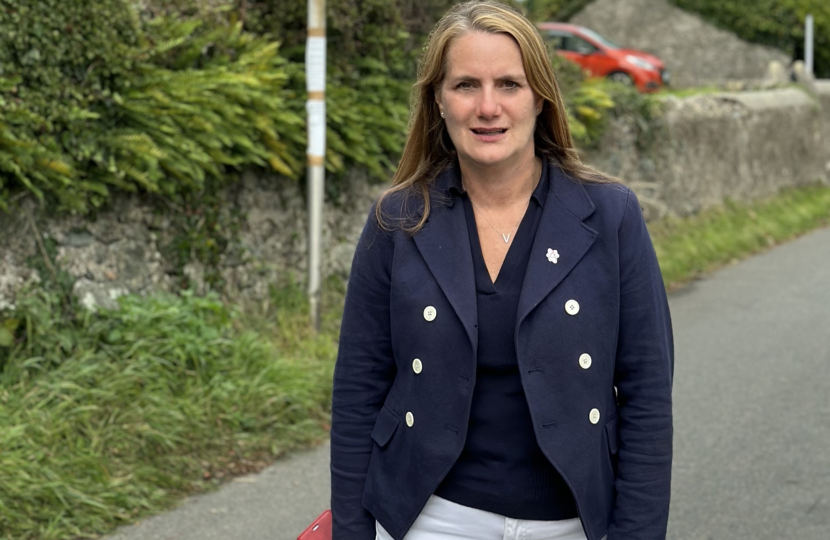
Cyn i mi fynd i’r brifysgol bu bron i mi farw mewn damwain ffordd ddifrifol. Rwy’n ddiolchgar iawn i’r llawfeddyg gwych – sydd â chartref yma ar Ynys Môn – a fu’n llaw-drin fy wyneb dros gyfnod o ddeng mlynedd.
Mae diogelwch ar y ffyrdd yn bwysig i’r rhan fwyaf o bobl ac yn arbennig o bwysig i mi.
Felly pam fod dros 430,000 o bobl, a’r nifer yn dal i dyfu – gan gynnwys 8,000 o fy etholaeth ar Ynys Môn, wedi arwyddo’r ddeiseb ‘Rydym am i Lywodraeth Cymru ddiddymu’r gyfraith drychinebus ynghylch y terfyn cyflymder o 20mya’? Pam fod y Gweinidog Llafur sy’n gyfrifol am wynebu’r terfyn cyflymder rhagosodedig newydd o 20mya yng Nghymru yn wynebu pleidlais o ddiffyg hyder yn y Senedd yr wythnos hon? Pam oedd y ddeddfwriaeth hon yn haeddu llai nag awr o drafodaeth yn y Senedd ym mis Gorffennaf y llynedd, na chafwyd unrhyw gyfraniad o gwbl iddi gan Aelod Plaid Cymru Ynys Môn o’r Senedd?
Before I went to university I nearly died in a serious road traffic accident. I am very grateful to the brilliant surgeon – who has a home here on Ynys Môn – that operated on my face over a ten year period.
Road safety is important to most people and particularly important to me.
So why have over 430,000 and counting – including 8,000 from my Ynys Môn constituency - signed the petition ‘We want the Welsh Government to rescind and remove the disastrous 20mph law’? Why is the Labour Minister responsible for implementing the new 20mph default speed limit in Wales facing a vote of no confidence in the Senedd this week? Why did this legislation deserve less than an hour of debate in the Senedd in July last year to which there was no contribution at all from Ynys Môn’s Plaid Cymru Member of the Senedd?
For up to date numbers and if you too wish to sign the petition please follow the link here: https://petitions.senedd.wales/petitions/245406
Many of my Ynys Môn constituents have written to me about the problems this decision has created for them, particularly following the decision by Welsh Government to cancel the third Menai crossing. There is anger that there was not more discussion, more explanation, more preparation. And there is frustration that, despite a petition showing the strength of feeling against the new law in Wales, the First Minister Mark Drakeford has refused point blank to even consider changing it.
The people contacting me are not speed-freaks or boy-racers. They are sensible law-abiding residents who are confused and angry - the kind of people who stick to speed limits because it is the law. One wrote to me saying “it seems to a lot of people that while we are hoping for investment on the Island we are then shutting the door in people’s faces.”
I completely agree that Ynys Môn needs investment and good quality jobs. Since the island elected me I have continued to fight to raise the profile of Ynys Môn on the global stage and have been successful in bringing investment and generating exciting new opportunities for local people. The UK Government is committed to levelling up places like Ynys Môn, as evidenced by £26m for Anglesey Freeport, £20m for the Holyhead Breakwater refurbishment, £17m from the Levelling Up Fund, £16m Shared Prosperity funding, almost £5m for the Hydrogen Hub, £3m Community Renewal funding and almost £1m from the Safer Streets Fund.
If the island uses these funds wisely, Ynys Môn has the opportunity and resources to enjoy an economic renaissance by welcoming new investment and delivering high-quality well-paid jobs for local people. I am determined to continue to deliver the opportunities Anglesey needs to protect our Welsh language and culture and ensure people across our island have a bright future – and that future is here.
I have brought many businesses to the island – Westinghouse, Rolls-Royce, GE-Hitachi, Airbus and more - to look at the island as a potential investment base. However, they have some important concerns:
- How will the lack of a reliable and robust infrastructure impact goods going between Ynys Môn and the mainland? This is why a third Menai crossing is vital.
- How will the islands poor public transport infrastructure impact people going to and from work? This is why we need better bus and train services across the island.
Here in North Wales we can only look on as Cardiff sits in the top 10 places in the UK for employment growth. That growth is achieved through a transport infrastructure that is fit for purpose.
The Welsh Government has invested £1.6bn in the South Wales Metro – ensuring connectivity of public transport to encourage growth. The M4 runs parallel to Cardiff, which means businesses can get their goods onto a motorway with fast links to the rest of the UK quickly.
Once again, by implementing a 20mph default limit, the Labour Government in Cardiff is side-lining North Wales and particularly Ynys Môn. Whilst “active travel” is all the rage and public transport is made easier down south, Anglesey’s elderly and vulnerable residents are being deprived of bus services and told to get on their bikes.
The implications of this 20mph speed limit go well beyond just making our journeys slower. It starves our communities, deters businesses and damages our economy.
Over the past fifty years we have seen a huge improvement in measures that keep us safe when we are on the roads. From seat belts to air bags our cars have been revolutionised. On our roads too we see traffic calming humps, better signage, speed cameras and more.
Despite a massive rise in the number of vehicles on the road, fatalities have significantly reduced. In 1966 nearly 8,000 people were killed on British roads. That figure has fallen to just under 1,700 in 2022.
In 1990 the UK Government passed its first Bill giving local authorities the ability to put 20mph speed limits in place where needed, when data showed that most road deaths happened in built up areas.
Over the years 20mph has become the de facto for the roads around schools, hospitals, playgrounds, etc. The 20mph signs – with their little red snail symbol – are a stark reminder that vulnerable people may be nearby and we should drive slowly and be vigilant. Along with traffic calming measures in these areas, deaths have dropped significantly.
On the face of it the Welsh Government’s introduction of a default 20mph speed limit would make sense.
The complaints are not about the need to control speed in built up areas and around areas like schools and hospitals. They are about a default 20mph speed limit, the way it was implemented, the impact it is having on their lives and the cost to the taxpayer of making the change.
The Welsh Government may try to argue that this is not a “blanket” 20mph speed limit, because local authorities can apply to have sections of road exempted. In order to do so there is an administrative process which will take up precious council time and resources, when our councils are already struggling for funding.
The Labour Government in Cardiff are pointing to their manifesto for the 2021 Senedd election as their mandate to make the change. It contained the following nine words "Make 20mph the default speed limit in residential areas".
On 12 July 2022, when the Senedd was still using hybrid working, the draft legislation was debated in Cardiff. The Welsh Government allotted less than an hour’s discussion time for it. That is less than an hour to debate a decision that has affected everyone’s lives dramatically. Despite the potential impact and the lack of debate, Plaid Cymru supported Labour’s proposal and it was passed. Had Plaid Cymru voted against, it is unlikely that the motion would have gone forward at that point.
So, what impact have we seen here on Ynys Môn?
One local business has told me that where they were considering expanding their operation to include a distribution hub on Anglesey they have shelved the idea and will now be looking over the border in England.
Other businesses have told me that their operating costs will have to go up because 20mph is not an economic speed for commercial vehicles so they will use more fuel and require more frequent servicing. When operating costs go up, this is passed on to the consumer through higher prices which means that local people will end up paying more and any company competing nationally or internationally will be further squeezed out of their markets.
Parents have been in touch because children have been arriving up to 20 minutes late for school because the bus timetable does not take account of the slower journey times.
Other bus users have made similar complaints – only adding to the woes of a group which has already had to adapt to timetable changes and cuts due to the Menai Bridge closure/restrictions and which is now facing further cuts in bus services from 27th September.
It stands to reason that if a journey takes longer, then a driver can do fewer journeys in his or her shift.
People are annoyed about the amount it has cost to implement this change – estimated at around £33m, with some of that money being given to English councils on the Welsh border. The Welsh Government’s own research puts the long-term cost to the Welsh economy at £4.5bn.
There is confusion about which roads are affected with some showing 30mph signs where they should be 20mph, roads where street lighting does not comply with the “residential area” criteria but with no indication of what the speed limit should be, towns on Anglesey where – if you take one route in you are told to stick to 20mph but if you take a different route the speed limit is apparently 30mph.
As we look ahead to the next General Election, it is important to remember that the Labour Leader has described the Welsh Government as providing a ‘blueprint for what Labour can do across the UK’…




